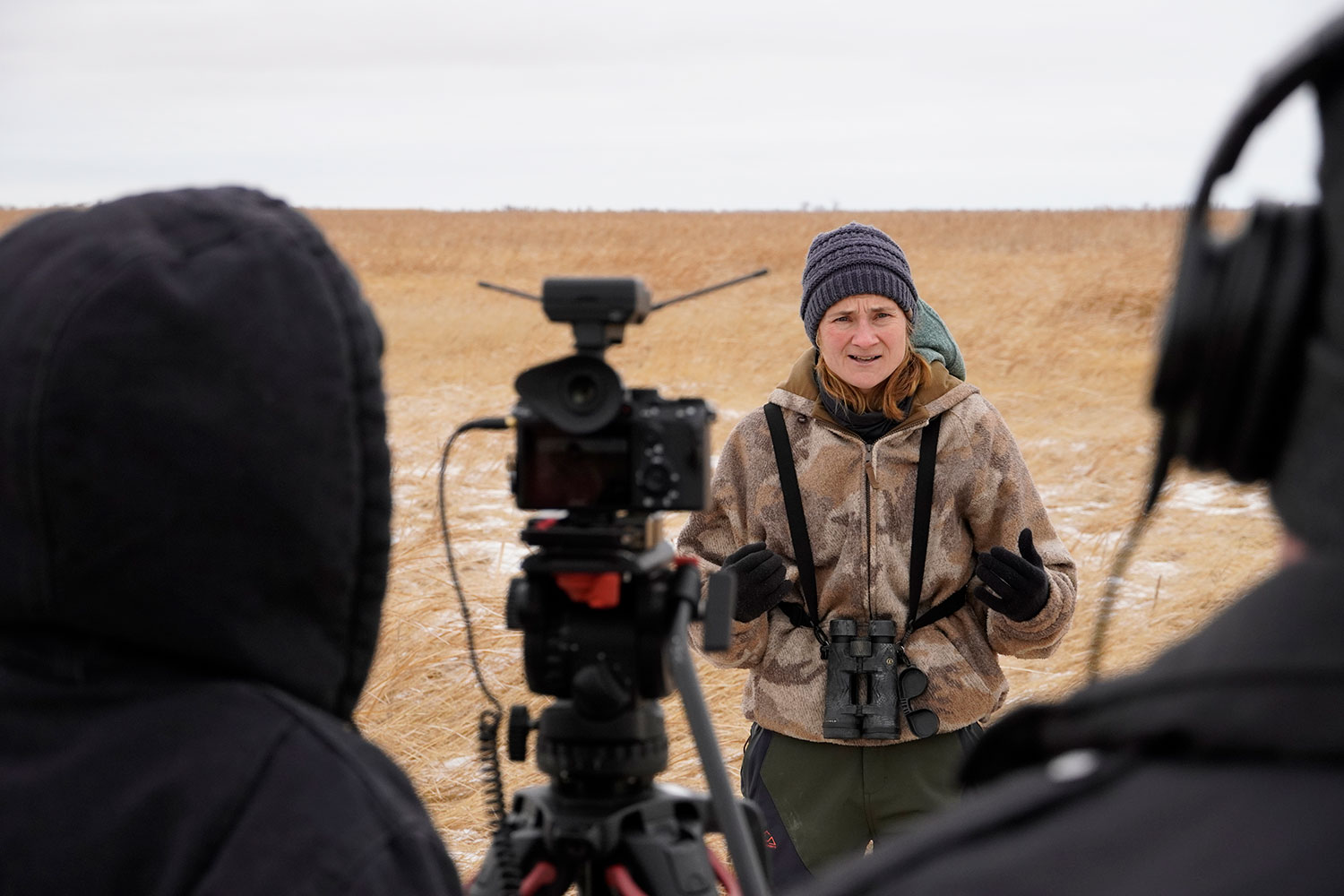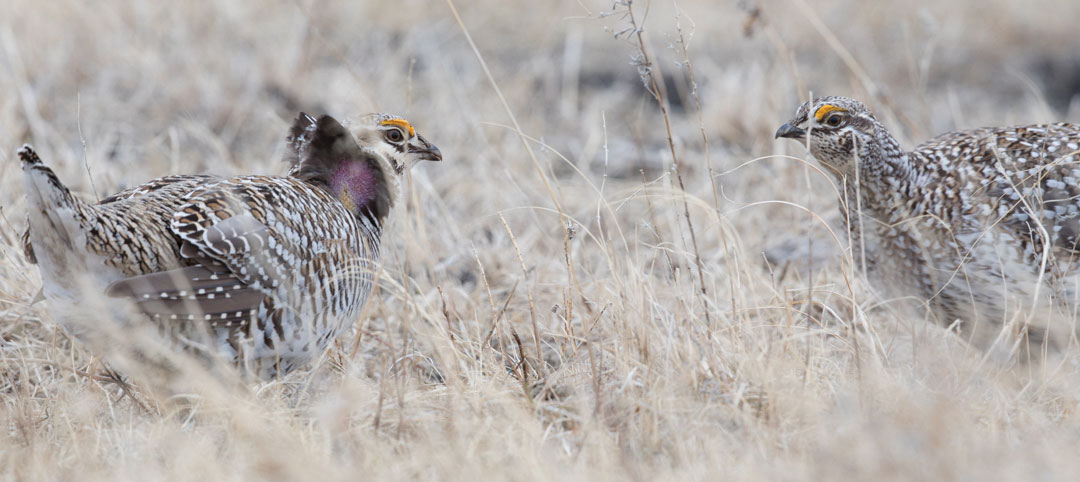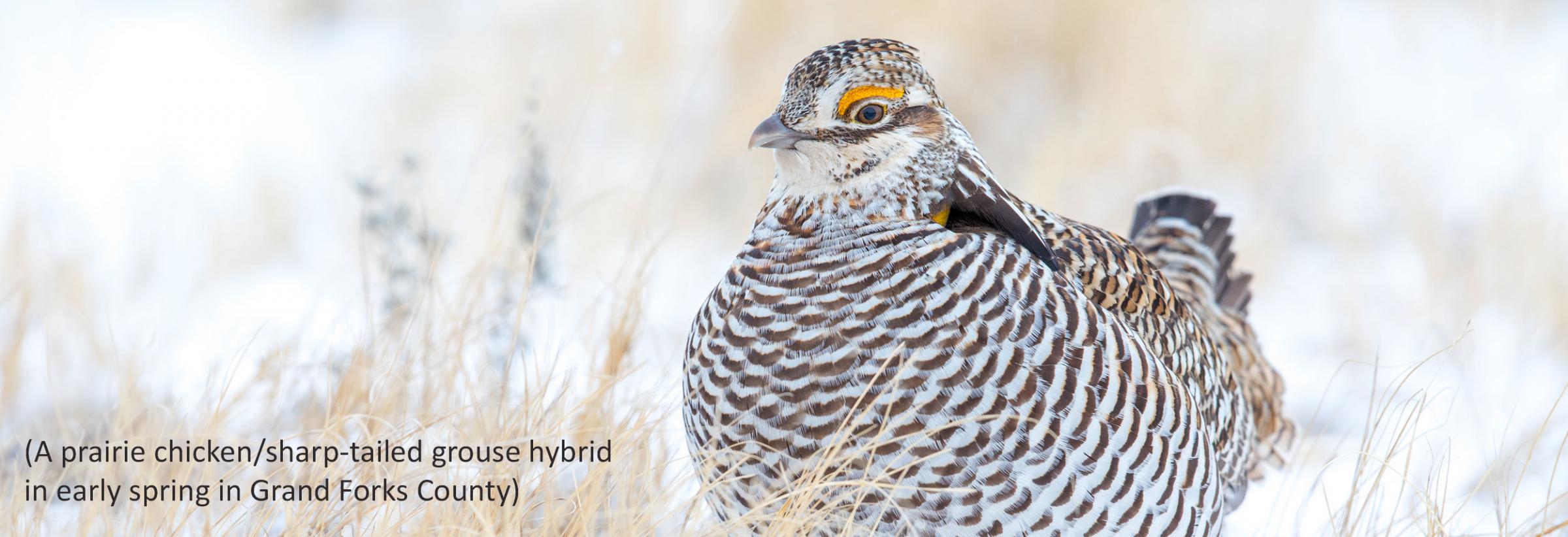A bird that followed in the dusty wash of homesteaders to North Dakota more than 100 years ago and once thrived in the collage of newly planted crops and age-old native grasses, continues to scratch out an existence today in the eastern part of the state.
While their numbers are nowhere near what they once were, greater prairie chickens (formerly called pinnated grouse), and the more abundant native sharp-tailed grouse, gather in spring on specific chunks of prairie that have been long used by generations of birds.
This showy and pleasingly noisy assemblage of prairie chickens and sharptails in courtship mode is lost on most passersby, with vehicle windows rolled tight against the cool early spring temperatures.

Susan Felege
Yet, there are some people – students with keen eyesight and hearing – bent on locating these birds, differentiating between species and counting heads as they shuffle about on ancient booming and dancing grounds.
To get a firmer handle on prairie chickens and sharp-tailed grouse populations in Grand Forks County, the North Dakota Game and Fish Department partnered with the University of North Dakota to survey both species during spring mating rituals when the prairie birds are easiest to observe and tally.
Jesse Kolar, Game and Fish Department upland game management supervisor, said this spring marked the third year of a three-year rotating program with UND where university students searched for and counted the harder-to-find prairie chickens and sharptails.
“UND came into the picture a few years ago, which was perfect because we don’t have a lot of staff this far east in the state and the staff we do have we are asking them to survey other species like ruffed grouse in the Pembina Hills,” Kolar said. “Historically, we contracted out these prairie grouse, prairie chicken surveys, but the biologist who did it for 15 years passed away three years ago, so we switched to an agreement with UND.”
Susan Felege, associate professor of wildlife ecology and management at UND, said the university and Game and Fish both benefit from this alliance.
“Hopefully, the Game and Fish Department gets really valuable data, particularly annual trends in what’s going on with both the prairie chickens and the sharp-tailed grouse,” she said. “But another real significant benefit is the assistance in training the next generation of wildlife professionals. The students get valuable experience out here on the ground counting birds, tallying up the data and helping to communicate that information back to the Game and Fish Department.”
Cailey Isaacson, a junior in UND’s fisheries and wildlife biology program, is in her second spring of early mornings surveying birds.
“I had never seen a prairie chicken before coming out here and I was unaware of their conservation status in the state,” she said. “I would say that I’m very fortunate because a lot of students don’t get this opportunity.”
In the early 2000s, the Game and Fish Department had limited prairie chicken seasons in the survey area and in southeastern North Dakota, the first in 2004.
That year, biologists estimated a population of about 1,200 birds in the Grand Forks area. Today’s population is probably fewer than 100 breeding individuals. (Biologists estimate a 1:1 male to female sex ratio and double the total count of males on known booming grounds to get a conservative population estimate.)
“Such little things can impact prairie chickens … they are kind of a sensitive species,” Kolar said. “They rely on expansive areas of tall grass prairies, so even Russian olive or cattail encroachment over the long haul shifts the scales in favor of sharptails instead of prairie chickens. And that’s what we are seeing here in Grand Forks County, which is not necessarily bad because the sharptails are doing well.”
If you’ve read historical accounts, there were once an untold number of prairie chickens in North Dakota, something that is likely difficult for today’s biologists and students alike to wrap their heads around.

Prairie chicken/sharp-tail grouse hybrid (left) facing off against a sharp-tailed grouse (right)
“I would think it would be one of the most amazing experiences if you ever had the chance to be on a prairie chicken booming ground back then, and especially if you were there before sunrise and you start to hear the booming sounds the males make that is just absolutely incredible,” Felege said. “If they were as abundant as some of the historical records define, I can’t even imagine what that sounded like and what feelings and emotions that would rise in someone sitting out watching the prairie come alive.”
Felege and her students start their survey efforts about March 15, driving designated routes on backroads, stopping every half-mile for 3-5 minutes and listening for both the booming chickens and the clucking sharptails.
“And then, starting on April 1, they actually go back to all the places where they’ve located these dancing grounds or booming grounds and they’ll count them, and they’ll go out and they’ll see how many of each species are there,” she said. “Students are also looking to see how many males versus females are there. Because what we’re actually tracking is the number of dancing sharptail males or booming prairie chicken males.”
Biologists say females do not show up consistently at the booming grounds, so it’s not practical to get a count on all females. Males provide a more reliable population barometer.
Isaacson said it’s easy to discern the sharptails from the male prairie chickens during courtship.
“When the prairie chickens are on their booming grounds and they are making the noise, doing their display, you’ll actually see the bright orange air sacks on their necks. They get really big and kind of look like they’re being filled up with air,” she said. “And they have pinnae feathers that stick up from the back of their head that almost look like giant ears. And they bob their heads up and down and while making this oohing sound over and over. It’s just a really deep sound that carries for miles. When you get close, you can feel it in your chest … it’s a unique experience.”
As is the case with prairie chickens and sharp-tailed grouse in Grand Forks County, it’s not uncommon to see the two species sharing a lek in spring. It’s not unheard of, either, to view birds that just don’t look entirely like they should.
“The greater prairie chicken that came into a booming ground I sat on this morning sounded different. It had a more of a slur to it than normal,” Kolar said. “And when I looked at it, I could tell it had speckling on the belly, which wasn’t right because prairie chickens are really barred across the belly.
“But this one had barring on the top of the breast, but then toward the belly it got more spotty and speckled like a sharptail grouse,” he added. “This is not uncommon. Sharp-tailed grouse and prairie chicken hybrids are reported most years in North Dakota where they overlap.”
Turns out, having a working relationship with UND and future wildlife professionals isn’t that uncommon, either.
“It’s good for Game and Fish to have a working relationship with UND and other universities,” Kolar said. “A large part of what the Game and Fish does focuses on research for game management. And so, having a tie to a local university is really suitable.”

Prairie chicken/sharp-tail grouse hybrid (left) facing off against a sharp-tailed grouse (right)




